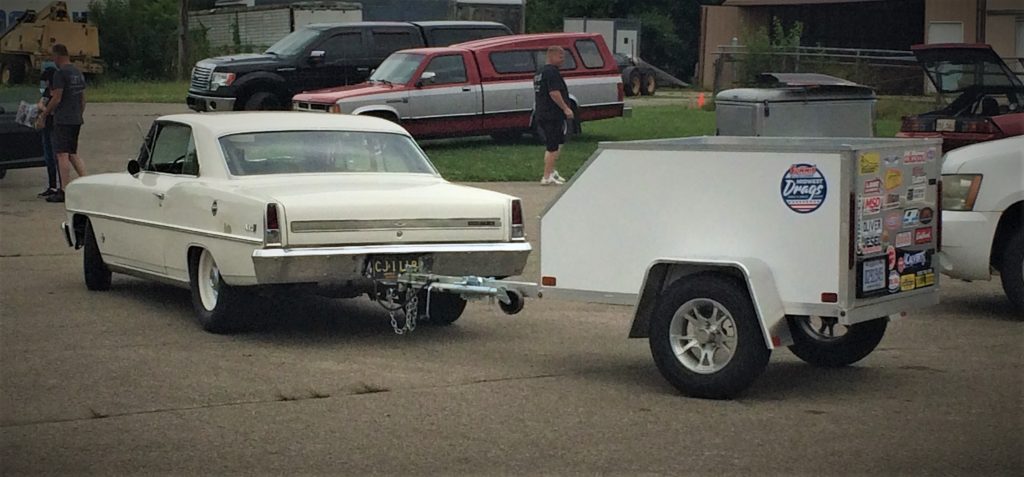Very bad things can happen when we load trailers improperly.
We were reminded of this fact after seeing video of U-Haul’s trailer-sway demonstration at the Commercial Vehicle Safety Alliance Conference last month:
Great demo by @uhaul today @CVSA Conference shows affect of weight distribution on trailer #weightforward #trailer. pic.twitter.com/veefMuWC4v
— OPCVC (@OPCVC) September 22, 2016
The good folks at Air Lift put together an excellent guide on trailer-loading methods that help get humans and cargo to their preferred destinations in good shape.
Because outside of zombie lore, there’s no such thing as being too alive.

How to Properly Load a Trailer
Whether towing a cargo trailer, transporting a race car, or towing a camping trailer, properly balancing the load and preparing the trailer and tow vehicle are critical for safe driving.
Placement of the load will determine the way the vehicle handles on the road.
One of the main causes of trailer sway is not having a large enough percentage of trailer tongue weight compared to gross trailer weight:
Tongue weight should be 10 percent to 15 percent of the overall trailer weight; although with a fifth wheel this could be as high as 25 percent.
How to Suppress Trailer Sway
Heavier cargo should be placed in the front of the trailer, ahead of the trailer’s axle.
The cargo must also be centered left-to-right and firmly tied down to prevent shifting. Top-heavy loads can cause problems not only in cornering but also under hard braking, and have a tendency to make the trailer “dive.”
The sudden increase of tongue weight in those moments decrease front axle loading when steering and braking are needed most.
Top-heavy items should be loaded first. This is important because these items need to be securely tied down. Tying them straight down is not secure enough. They need to be tied off at several angles or they could fall over with an abrupt change in speed or direction. This is best accomplished when the trailer is empty.
The Rule of Thumb for Loading Trailers
Whether it’s a conventional, fifth-wheel, or gooseneck trailer, always adhere to the rule of thumb for loading the trailer:
Load the front of the trailer first, placing 60 percent of the weight forward of the front axle, with the weight evenly distributed side to side.
By way of example: a correctly loaded double axle 18-foot car trailer with a 146-inch wheelbase and gross trailer weight of 2,200 pounds would have a tongue weight of about 300 pounds.
It’s obvious that this 300 pounds will cause the rear of the tow-vehicle to squat. Not only will that reduce the exit angle and rear ground clearance, but the vehicle’s front end will also be lightened, causing the front tires to have less contact with the road. That’s bad for steering, braking and overall stability.
By properly distributing weight to all four tires, Air Lift air spring kits will level and stabilize the vehicle when pulling or carrying a heavy load, thus restoring the vehicle’s balance at the same time as:
- Eliminating squat – Proper weight distribution to all tires eliminates squat and improves steering, braking, and tire wear.
- Improving headlight aim – Only level and stable vehicles provide safe and proper headlight aim which is critical for driving safely at night.
- Improving handling and ride quality – Air Lift’s progressive spring rate absorbs road bumps and keeps the tires on the road for better handling.
- Overcoming bottoming out – Air Lift air spring kits restore normal ride height, reducing suspension wear and eliminating bottoming out on road bumps.
- Controlling sway and body roll – Air springs increase spring rate and vastly improve vehicle stability. When towing a trailer, the air springs maintain the vehicle’s ride height which reduces trailer sway. Less roll and sway means a safer and more comfortable ride. This is also critical for motor homes or pickups with slide-in campers. These types of vehicles have a high center of gravity and a large surface area, and are therefore heavily impacted by strong winds.
While stiffer steel springs may be considered, they are a trade-off: Compromising ride comfort for load-hauling capacity.
Air Lift adjustable air spring kits on the other hand allow infinite suspension adjustment to cope with any load or road condition. Simply add air when towing or hauling heavy loads and then release the air for a softer ride when unloaded.
This is accomplished by attaching an air line to each spring, allowing inflation or deflation through a Schrader valve. Most air springs are fully adjustable from 5 to 100 psi and for optimal convenience an Air Lift on-board air compressor system can be installed. This allows for inflation or deflation from inside or outside the vehicle at the touch of a button.
Fitted to the existing suspension, installation is fast and simple and in most applications requires no drilling into the vehicle’s frame.
For leaf spring vehicles, the adjustable air springs mount on top of the axles or leaf springs, and for vehicles with coil springs, the air springs easily fit inside the coils.
Before setting off on a journey, it’s important to always ensure the laden trailer and tow vehicle never exceed the Gross Vehicle Weight Rating or the Gross Axle Weight Rating.
SOURCE: Air Lift

Comments